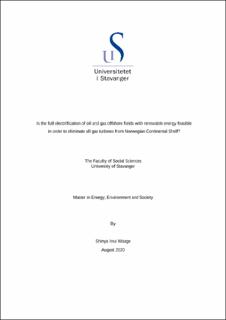| dc.description.abstract | In 2014, 16% of Norway’s GDP came from oil and gas industry and 57% of export were oil and gas related products. (Hass, et al., 2017) At the same time, 27.6% of nationwide greenhouse gas emission in 2018 came from oil and gas production activities such as gas turbine and flaring. (Statistics Norway, 2020) Hence, the sustainable development for Norway may be continuing oil and gas extraction for its economy while reducing greenhouse gas emission from oil and gas extraction activities for Norway’s and global environment. Electrification of offshore fields on Norwegian Continental Shelf with renewable energy can be a solution for Norway’s sustainable development. The feasibility of electrification of offshore fields with shore power, wind power and hydrogen storage were examined through comprehensive analysis including technological, economic, political and social analysis.
Electrification with shore power is currently the most popular method since many fields are already electrified and planned to be electrified. Economically, the estimate cost of full electrification with shore power was 54.1 billion NOK. Politically, it was indicated that there is political consensus on this technology. Socially, 53% people can potentially support of full electrification project. Hence, it was concluded as the full electrification with shore power is feasible.
Secondly, offshore wind technology was assessed. Although floating offshore wind power is relatively newly developed, it could be said that technology is mature enough for large scale deployment. Economically, on the other hands, the cost of installation was estimated 118 to 152 billion NOK. Politically, 71% of representatives at parliament can be supportive. Potential social acceptance was estimated as 53%. However, despite its high feasibility, inflexibility of wind power can be a deal breaker for full electrification with just his technology.
Hydrogen production and storage can solve the inflexibility of offshore wind power. Electrification of offshore fields with wind power and hydrogen storage was assessed. Technologically, hydrogen can be generated with electricity and water by electrolyzer. In addition, hydrogen can generate electricity with fuel cell. These two technologies can be combined, called reversible fuel cell. Economically, the total estimated cost of wind turbines with hydrogen storage was 125 billion NOK to 178.6 billion NOK. Politically, the total 42 % of representatives at parliament can be supportive while 37% of representatives can be against. Rest of 21% of representatives remained as unclear. Socially, it is likely same or similar to electrification with wind power; hence, 53% of social support can be applied. It can be said that the full electrification of offshore fields with offshore wind and hydrogen storage is feasible; however, there are few ‘if’ exist.
To sum up, it can be said that is feasible that offshore fields on Norwegian Continental Shelf can be fully electrified with shore power and / or offshore wind power with hydrogen storage.
The author recommends utilizing all technologies; submarine cables, offshore wind and hydrogen storage for the risk hedge and further development of future export system. | en_US |
